Research Lab: Graduate Students

|

|

|

|
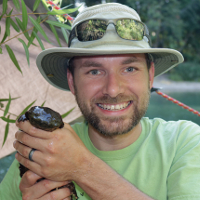
|
Dr. Mathis' Lab SupervisorBen DaltonBachelor's degree from William Jewell College
|
Current Graduate Students
Caleb O'NealBachelor's Degree from Harding University
|
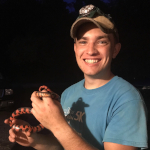
|
Sarah WhiteBachelor's Degree from Missouri State University
|

|
Megan MosierBachelor's Degree from Christian Brothers University
|
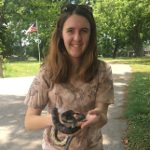
|
Shannon JohnsonBachelor's Degree from University of Central Missouri
|

|
Abbie KnudsenBachelor's Degree from Drury University
|

|
Past Graduate Students
After Graduation |
Awards |
Publications |
||
|---|---|---|---|---|

|
Stephanie Morrison MS, 2019. Behavioral analysis of electroshocked egg and subadult Cryptobranchus alleganiensis alleganiensis and larvae with yolk, larvae post-yolk, and post-metamprphic juvenile Cryptobranchus alleganiensis bishopi |
Biology Teacher, Christian Brothers College High School |
Best Student Presentation, Hellbender SYmposium, 2019 |
|

|
Amber Hunter MS, 2019. Recovery of domestic behaviors by a parasitic ant (Formica subintegra) in the absence of its host (Formica subsericea) |
Outstanding Oral Presentation, MSU Interdisciplinary Forum, 2018 |
||

|
Katy Gardner MS, 2019. Response to conspecific alarm cues by Spotted Salamanders (Ambystoma maculatum) larvae. |
PhD Student, Utah State University |
Outstanding Oral Presentation, MSU Interdisciplinary Forum, 2018
|
Ethol Ecol Evol |
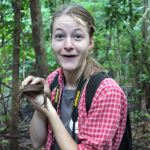
|
Sarah Heimbach MS, 2019. Territorial behavior of the Ozark Zigzag Salamander, Plethodon angusticlavius, altered by mode of predator cue and sex of intruder. |
|||

|
Colton Lynn MS, 2018. Territorial Behavior in Southern Red-Backed and Ozark Zigzag Salamanders |
Oregon National Primate Research Center, Research Assistant 2 |
Distinguished Biology TA, 2018
|
Behaviour 156: 1017-1037 |

|
Rachel Settle MS, 2017. Quantitative behavioral analysis of Ozark Hellbender reproduction and paternal care. |
Fisheries and Wildlife Biological Scientist, Florida Fish and Wildlife Conservation Commission |
J Ethol 2018: 1-8
|
|
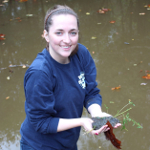
|
Kayla Shelton MS, 2016. Behavioral responses of Ringed and Spotted Salamanders to diet-related cues from predators. |
|
||

|
Kelsey Anderson MS, 2016. Friends in low places: Responses of a benthic stream fish to intra-guild alarm cues. |
Biological Science Technician, USFWS |
Outstanding Thesis Award, 2015
|
ethology 122: 954-962 |

|
Lauren Rudolph MS, 2015. Variation in behavior of different populations and sex classes of paedomorphic Oklahoma salamanders |
|
||
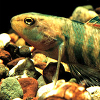
|
Wafa Abudayah MS, 2014. Predator recognition learning in rainbow darters (Etheostoma caeruleum) |
J Fish Biol 89: 1612-1623 |
||

|
Rachel Bortosky. MS, 2014. Honest signaling in aggressive contests between Ozark zigzag salamanders (Plethodon angusticlavius) |
Adjunct, Ozarks Community Technical College |
Copeia 104: 60-66 |
|

|
Travis Reeder. MS, 2013. A behavioral syndrome in the southern red-backed salamander (Plethodon serratus) |
Reptile Keeper, San Diego Zoo |
||

|
Emilee Helton. MS, 2013. Learning of dietary cues by embryos and larvae of ringed salamanders (Ambystoma annulatum) |
Naturalist, Grand Teton National Park |
Animal behaviour 142: 199-206 |
|

|
Ben Dalton. Identification of sex and parasitism via chemical cues by the Ozark zigzag salamander. |
Lab Supervisor, Missouri State University |
Chemoecology 24:189-199 |
|

|
Robert Hunt. MS, 2011, Behavioral and metabolic responses of juvenile spotted salamanders (Ambystoma maculatum) to alarm cues from damaged skin and predator diet. |
Watershed Center Coord, Watershed Comm of the Ozarks |
Ethol Ecol Evol |
|

|
Jenny Parsons. MS, 2010. Response to predation risk by territory owners and intruders in Ozark zigzag salamanders. |
Vet Asst, Springfield Animal Advocacy |
||

|
David Woods. MS, 2008. Sub-lethal effects of copper on foraging and alarm behavior of rainbow darters (Etheostoma caeruleum). |
Fish Biologist, Missouri Department of Conservation |
Behaviour 146:1565-1572 |
|

|
Brian Gall. MS, 2008. Predator-prey interactions between hellbenders (Cryptobranchus alleganiensis alleganiensis and C. a. bishopi) and native and nonnative fishes. |
PhD, Utah State University
|
MSU Biology Department Outstanding Thesis Award |
Behaviour 146:1565-1572 |

|
Morgan Presley. MS, 2008, Foraging tactics of the Ozark zigzag salamander under predation pressure |
|||

|
Kyle Shull. MS, 2007. Influence of physical stress, sex, and body size on metabolic rates of Ozark zigzag salamanders, Plethodon angusticlavius. |
Dental School |
||

|
Nathan Windel. MS, 2005. Behavioral and metabolic responses o f the southern red-backed salamander (Plethodon serratus) to predatory stimuli: influence of body size. |
High school science teacher |
Distinguished Thesis Award: Biology Dept & MSU overall
|
Proc Royal Soc B 275: 2603–2607 |

|
Angela Gibson. MS, 2004. Experience with chemical cues influences subsequent behavior of rainbow darters, Etheostoma caeruluem. |
Curator of Africa exhibit, Dickerson Park Zoo, Springfield, Missouri |
J Fish Biol 69:224-232 |
|

|
Shem Unger. MS, 2003. Sperm production and larval development in hellbenders (Cryptobranchus alleganiensis alleganiensis and C. a. bishopi): a comparison of declining and stable populations. |
PhD, Purdue University
|
Distinguished Thesis Award: Biology Dept & MSU overall |
Am Midl Nat170:382-392
|
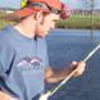
|
Caleb Hickman. MS, 2002. Response of salamanders to chemical stimuli from predators in natural habitats |
PhD, Univ Wisconsin
|
Finalist, Herpetologists' League Jaeger Award |
Herpetologica 60:203-210
|

|
Amy Commens. MS, 2000. Response of three species of darters of the genus Etheostoma to chemical alarm signals from conspecfics and congeners |
Biologist, U.S. Fish and Wildlife Service |
Copeia 2007:838-843 |
|

|
Paul Frese. MS, 2000. Spatial activity, growth, and population characteristics of Siren intermedia in an intensively managed wetland. |
Iowa Dept of Natural Resources |
Southwest Nat 48:534-542 |
|

|
Todd Watson. MS, 2001. The influence of predation risk on the foraging and territorial behavior of the Ozark zigzag salamander (Plethodon angusticlavius) |
Where oh where is Todd? |
Behav Proc 65:201-209 |
|

|
Benjamin Wheeler.MS, 1999. Status of the Ozark hellbender (Cryptobranchus alleganiensis bishopi): a long-term assessment. |
PhD, Arkansas State University
|
Biol Conserv 109:151-156 |
|

|
Aaron Sullivan. MS, 1999. Reproduction, body condition and dietary variation of the lesser siren (Siren intermedia). |
PhD, State University of New York at Binghamton
|
J Herpetol 34:607-611 |
|

|
Ethan Prosen. MS, 1999. Status of the eastern hellbeners (Cryptobranchus alleganiensis alleganiensis) in Missouri: a comparison of past and present populations. |
PhD, University of Louisiana at Lafayette
|
MSU Biology Department Distinguished Thesis Award |
Biol Conserv 109:151-156 |

|
Daria Maksimowich. MS, 1998. A role for parasites in the behavior of the Ozark zigzag salamander, Plethodon angusticlavius. |
Community Pet Hospital, Thornton, CO |
Acta Ethol 3:83-87
|
|

|
Kaye Goddard. MS, 1996. Opercular flaps as sexual ornaments for male longear sunfish. |
Biologist, General Pet |
Best Master's Thesis Award, MO chapter of the American Fisheries Society |
Ethology 106:631-643
|

|
David Woody. MS, 1996. The role of alarm pheromones in predation avoidance by adult central newts, Notophthalmus viridescens. |
Johnson and Johnson, La Jolla, CA |
Copeia 1998:1027-1031
|

